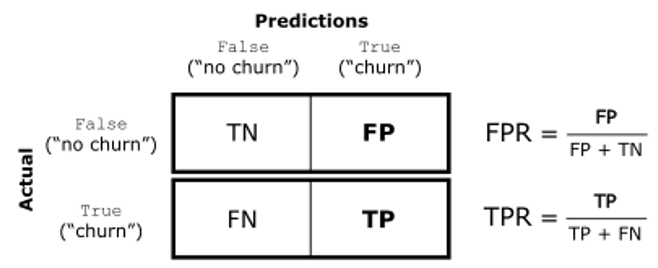Understanding Naïve Bayes Algorithm
Naïve Bayes is a classical machine learning algorithm. By reading this post, you will understand this algorithm and implement a Naïve Bayes classifier for classifying the target customer of an ad. by the features of the customer.
Naïve Bayes Algorithm, mainly refers Multinomial Naïve Bayes Classifier, is a machine learning algorithm for classification. It mathematically based on the Bayes Theorem:
$$P(\text{class}|\text{feature}) = \frac{P(\text{feature}|\text{class})P(\text{class})}{P(\text{feature})}$$
It is easy to prove based on some prior knowledge on Joint probability
$$P(A\cap B)=P(A|B) \cdot P(B)$$
$$P(A\cap B)=P(B|A) \cdot P(A)$$
Hence, we can connect these two formula via $P(A\cap B)$
$$P(A|B) \cdot P(B) = P(B|A) \cdot P(A)$$
Divide both side with $P(B)$,
$$P(A|B) = \frac{P(B|A) \cdot P(A)}{P(B)}$$
Bayes Theorem
Here is an exercise on Wikipedia: Drug testing

Suppose, a particular test for whether someone has been using cannabis is 90% sensitive, meaning the true positive rate (TPR) = 0.90. Therefore, it leads to 90% true positive results (correct identification of drug use) for cannabis users.
The test is also 80% specific, meaning true negative rate (TNR) = 0.80. Therefore, the test correctly identifies 80% of non-use for non-users, but also generates 20% false positives, or false positive rate (FPR) = 0.20, for non-users.
Assuming 0.05 prevalence, meaning 5% of people use cannabis, what is the probability that a random person who tests positive is really a cannabis user?
$$P(pred_T|real_T) = 0.9$$
$$P(pred_T|real_F) = 0.2$$
$$P(real_T) = 0.05$$
find $P(real_T|pred_T) = ?$
$$P(real_T|pred_T) = \frac{P(pred_T|real_T)P(real_T)}{P(pred_T)}$$
$$P(pred_T)=P(pred_T|real_T)*P(real_T)+P(pred_T|real_F)*P(real_F)$$
$$=\frac{0.9*0.05}{0.05*0.9+0.95*0.2}=0.1914893617$$
Classes and Features
The idea here is to find a class (or say classify) of given features, where class refers to prediction result and features refers all attributes for a specific $X$.
Note that we let $X_i$ be monthly income, martial status of a person, or frequencies of some words in an email, or number of bedrooms, size, distance from subway of a house (which could determine its renting price).
Besides, we could let $y$ be a result corresponding to these $X_i$'s, such as monthly income, martial status of a person may infer the willingness of purchasing by an advertisement, frequencies of some words (free, refund, paid, special) could infer the spam email.
Priors
Since we have figured out the $X$ (feature) and $y$ (class), it is clear that we have frequencies of $X$ and $y$ from statistics. Mathematically, they are $P(\text{feature}_i) = \frac{n(\text{feature}_i)}{n(\text{all})} $ and $P(\text{class}) = \frac{n(\text{class})}{n(\text{all})}$. These kind of probabilities are called priors.
According to the Bayes Theorem which mentioned before:
$$P(\text{class}|\text{feature}) = \frac{P(\text{feature}|\text{class})P(\text{class})}{P(\text{feature})}$$
The bridge connects $P(\text{class}|\text{feature})$ and priors are $P(\text{feature}|\text{class})$. But what are they?
Conditional Probability
In Statistics $P(A|B)$ is conditional probability. $P(A|B)$ is the probability of event $A$ given that event $B$ has occurred. For example, let event B as earthquake, and event A as tsunami. $P(\text{tsunami}|\text{earthquake})$ means when an earthquake happens, the probability of happening a tsunami at the same time. Out of common sense, $P(\text{tsunami}|\text{earthquake})$ is lower when the location of earthquake is far from a coast.
Back to the feature-class, $P(\text{class}|\text{feature})$ and $P(\text{feature}|\text{class})$ refer to two different condition, obviously. Let us make the feature-class be:
$A=P(\text{is spam}|\text{free, refund, paid, special})$ means when a email contains these words: free, refund, paid, special; the probability of it is a spam.
$B=P(\text{free, refund, paid, special}|\text{is spam})$ means when a email is spam (we have already know that), the probability of it containing these words: free, refund, paid, special.
Posteriors
From the previous A and B, we know that B can be easily calculated from given data (in machine learning, we always have some lines of data as input of algorithms), which is "empirical".
While A refers the probability of the email is a spam if given data contains free, refund, paid, special. When the system read an email, and get the vocabulary frequency, it could have these situations:
free contains | not contains
refund contains | not contains
paid contains | not contains
special contains | not containsThere could be $2^4$ possible combinations of the 4 words. For all emails, they must meet one of the combinations of these words. Hence, we can get a True-False attributes set for the 4 words.
For example, (True, True, True, False) indicates that email contains "free", "refund", "paid" but not contains "special". Then we can get two possibilities.
$$C = P(\text{is spam}|\text{free, refund, paid, not special})$$
$$D = P(\text{is not spam}|\text{free, refund, paid, not special})$$
The task, to find out if the email contains free, refund, paid, but not contains special is a spam, could be converted into find $\max(C, D)$. If C is larger, the email is higher likely to be a spam. Then the classifier could tell the probability of the email contains free, refund, paid, but not contains special is a spam (such as 75%).
Integration
The class-feature $P(\text{class}|\text{feature})$ works as classifier, and it is calculated by Bayes Theorem:
$$P(\text{class}|\text{feature}) = \frac{P(\text{feature}|\text{class})P(\text{class})}{P(\text{feature})}$$
The training process could be mathematically converted into calculation by the given formula.
With the aid of following formulas
$$P(\text{f}|\text{c}) = P(\text{f}_1|\text{c}) \times P(\text{f}_2|\text{c}) \times ... \times P(\text{f}_n|\text{c})$$
$$P(\text{f}) = P(\text{f}_1) \times P(\text{f}_2) \times ... \times P(\text{f}_n)$$
We could cumprod each probabilities and get the posteriors easily.
Implementation
The code implements a Naïve Bayes classifier for finding out if a user will purchase from the advertisement from given features: gender, age, estimation salary.
The data could be downloaded from: https://raw.githubusercontent.com/Ex10si0n/machine-learning/main/naive-bayes/data.csv
wget https://raw.githubusercontent.com/Ex10si0n/machine-learning/main/naive-bayes/data.csvStep 0: Preprocessing
def split_data(data, ratio):
np.random.shuffle(data)
train_size = int(len(data) * ratio)
return data[:train_size], data[train_size:]
def main():
f = open('data.csv')
data = np.array(list(csv.reader(f, delimiter=',')))
# Cut the first row (headers) and first column (id)
header = data[0, 1:]
data = data[1:, 1:]
# Split data into training and testing sets
train, test = split_data(data, 0.8)
# Split data into features and labels
train_x = train[:, :-1]
train_y = train[:, -1]
test_x = test[:, :-1]
test_y = test[:, -1]
naive_bayes_classify(header, train_x, train_y, test_x[0], test_y[0])
if __name__ == "__main__":
main()Step 1: Calculate all of the conditional probabilities
unique_labels = np.unique(train_y)
p_labels = []
for label in unique_labels:
count = np.count_nonzero(train_y == label)
p_labels.append(count / len(train_y))
p_features_given_label = []
for label in unique_labels:
relevant_rows = train_x[train_y == label]
for feature in range(len(test_x)):
count = np.count_nonzero(relevant_rows[:, feature] == test_x[feature])
p = count / len(relevant_rows)
p_features_given_label.append(p)
print("P({}|{}) = {}".format(header[feature], 'purchase' if label == '1' else 'not purchase', p))Step 2: Calculate all of the priors
p_label_given_features = []
for i in range(len(unique_labels)):
p = p_labels[i]
for j in range(len(test_x)):
p *= p_features_given_label[i * len(test_x) + j]
print("P({}|{}) = {}".format('purchase' if unique_labels[i] == '1' else 'not purchase', header[j], p))
p_label_given_features.append(p)Step 3: Applying the Bayes Theorem
print("P(purchase|{}) = {}".format(test_x, p_label_given_features[0]))
print("P(not purchase|{}) = {}".format(test_x, p_label_given_features[1]))
print("Predicted Label:", 'purchase' if unique_labels[np.argmax(p_label_given_features)] == '1' else 'not purchase')Result:
========= Conditions =========
P(Gender|not purchase) = 0.5
P(Age|not purchase) = 0.04411764705882353
P(EstimatedSalary|not purchase) = 0.024509803921568627
P(Gender|purchase) = 0.5344827586206896
P(Age|purchase) = 0.017241379310344827
P(EstimatedSalary|purchase) = 0.0
========= Priors =========
P(not purchase|Gender) = 0.31875
P(not purchase|Age) = 0.0140625
P(not purchase|EstimatedSalary) = 0.00034466911764705885
P(purchase|Gender) = 0.19374999999999998
P(purchase|Age) = 0.00334051724137931
P(purchase|EstimatedSalary) = 0.0
========= Results =========
P(purchase|['Female' '27' '57000']) = 0.00034466911764705885
P(not purchase|['Female' '27' '57000']) = 0.0
Predicted Label: not purchase
Actual Label: not purchaseView full code here:
Conclusion
Naïve Bayes is a fast and simple algorithm that requires a little training data, making it suitable for large datasets or data with limited labeled examples. It also has the advantage of being able to handle multiple classes, making it a popular choice for text classification and spam filtering.
In conclusion, Naïve Bayes is a simple yet powerful algorithm that is widely used in many real-world applications. Despite its "naïve" assumption of independent features, it has proven to be a reliable method for classification in many scenarios.

